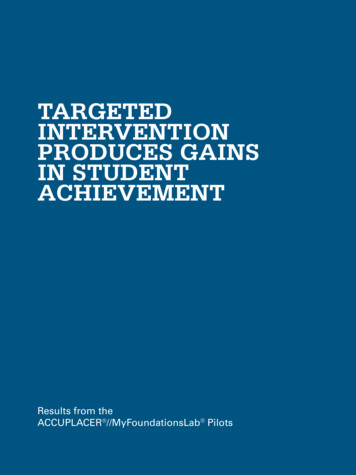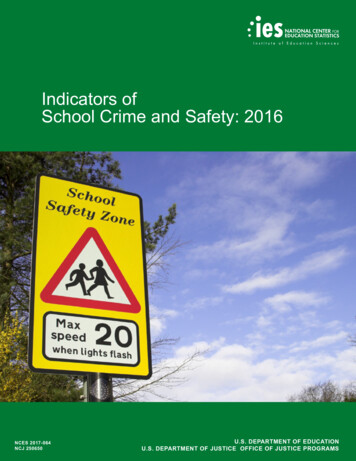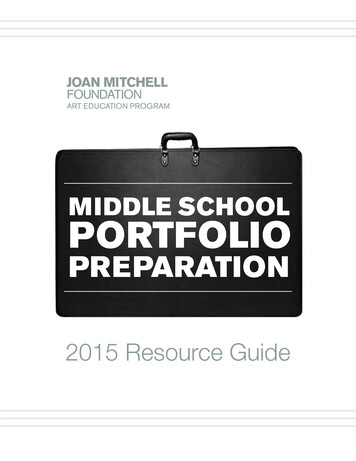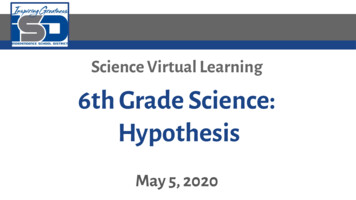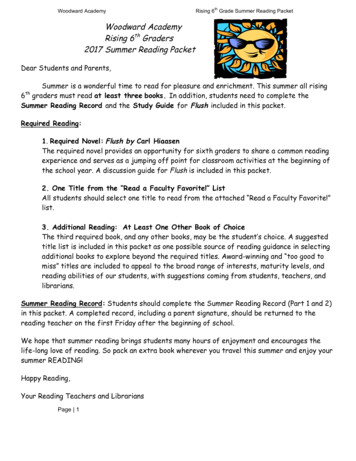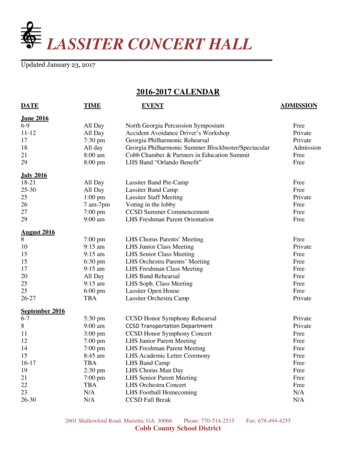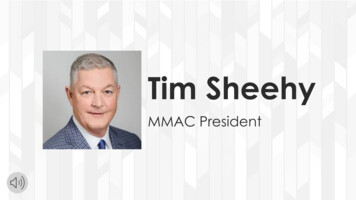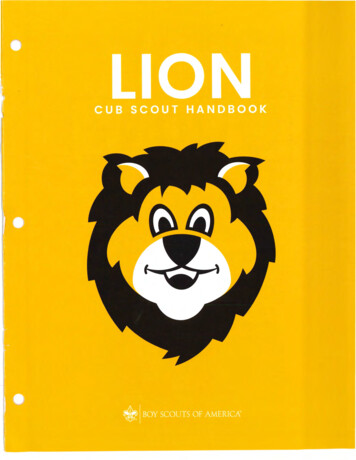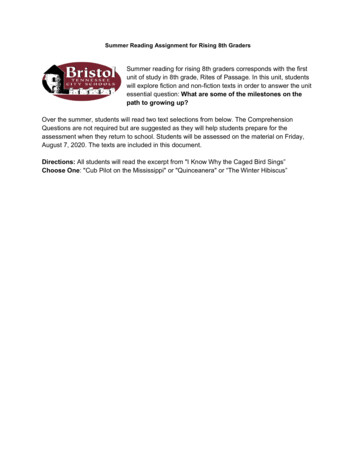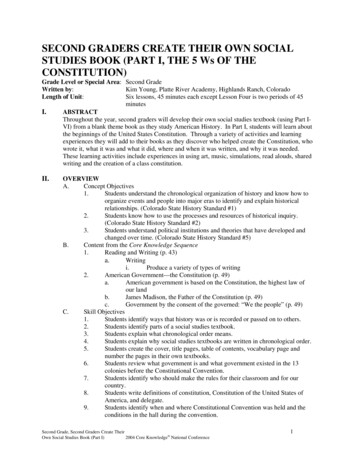
Transcription
SECOND GRADERS CREATE THEIR OWN SOCIALSTUDIES BOOK (PART I, THE 5 Ws OF THECONSTITUTION)Grade Level or Special Area: Second GradeWritten by:Kim Young, Platte River Academy, Highlands Ranch, ColoradoLength of Unit:Six lessons, 45 minutes each except Lesson Four is two periods of 45minutesI.ABSTRACTThroughout the year, second graders will develop their own social studies textbook (using Part IVI) from a blank theme book as they study American History. In Part I, students will learn aboutthe beginnings of the United States Constitution. Through a variety of activities and learningexperiences they will add to their books as they discover who helped create the Constitution, whowrote it, what it was and what it did, where and when it was written, and why it was needed.These learning activities include experiences in using art, music, simulations, read alouds, sharedwriting and the creation of a class constitution.II.OVERVIEWA.Concept Objectives1.Students understand the chronological organization of history and know how toorganize events and people into major eras to identify and explain historicalrelationships. (Colorado State History Standard #1)2.Students know how to use the processes and resources of historical inquiry.(Colorado State History Standard #2)3.Students understand political institutions and theories that have developed andchanged over time. (Colorado State History Standard #5)B.Content from the Core Knowledge Sequence1.Reading and Writing (p. 43)a.Writingi.Produce a variety of types of writing2.American Government—the Constitution (p. 49)a.American government is based on the Constitution, the highest law ofour landb.James Madison, the Father of the Constitution (p. 49)c.Government by the consent of the governed: “We the people” (p. 49)C.Skill Objectives1.Students identify ways that history was or is recorded or passed on to others.2.Students identify parts of a social studies textbook.3.Students explain what chronological order means.4.Students explain why social studies textbooks are written in chronological order.5.Students create the cover, title pages, table of contents, vocabulary page andnumber the pages in their own textbooks.6.Students review what government is and what government existed in the 13colonies before the Constitutional Convention.7.Students identify who should make the rules for their classroom and for ourcountry.8.Students write definitions of constitution, Constitution of the United States ofAmerica, and delegate.9.Students identify when and where Constitutional Convention was held and theconditions in the hall during the convention.Second Grade, Second Graders Create TheirOwn Social Studies Book (Part I)2004 Core Knowledge National Conference1
.27.28.29.Students draw Independence Hall.Students write definitions of legend, committee, compromise and debate.Students correctly trace a map of the 13 colonies.Students identify what a legend is and create a legend for the map.Students identify the state abbreviations for the 13 colonies.Students label the 13 colonies on their map with the state abbreviations.Students color the map of the 13 colonies using the legend to identify largecolonies and small colonies.Students identify conditions at the Constitutional Convention after discussingthem and experiencing them in simulation.Students show understanding of compromise by practicing it in committees.Students identify ideas discussed at the Constitutional Convention.Students participate in a role-play of the Constitutional Convention using theirassigned delegate role.Students show understanding of the three branches of our government bycompleting the diagram in their book.Students learn to work together in committees to create two class rules.Students organize and write a Class Constitution.Students define preamble.Students create a preamble for the Class Constitution.Students identify one reason that James Madison was called the Father of theConstitution.Students identify one reason that the Constitution is important.Students display understanding of signing a document by signing the ClassConstitution.Students create symbols for the concepts they have learned about theConstitution.III.BACKGROUND KNOWLEDGEA.For Teachers1.Hakim, Joy. A History of Us. From Colonies to Country 1710-1790, Book 3.New York: Oxford University Press, 1999. 0-19-512756-0.2.Hirsch, E.D., Jr. What Your 2nd Grader Needs to Know. New York: Dell, 1999.0-385-31843-X.3.Prolman, Marilyn. Cornerstones of Freedom. The Constitution. Chicago:Children’s Press. 0-516-06692-7.B.For Students1.Students should understand first grade Core Knowledge American Historycontent –symbols, democracy, history, government, George Washington asFather of our country, the original thirteen colonies, and the Declaration ofIndependence.2.Have art teacher teach portrait drawing as early in the year as possible.3.Students should understand odd and even numbers, horizontal and vertical lines,shapes (oval, square, almond) and know how to write numerals from 1-200.IV.RESOURCESA.Catrow, David. We the Kids. New York: Scholastic, Inc., 2002. 0-439-45807-2.(Lesson Five)B.Fritz, Jean. Shh! We’re Writing the Constitution. New York: G.P. Putnam’s Sons, 1987.0-399-21403-8. (Culminating Activity)Second Grade, Second Graders Create TheirOwn Social Studies Book (Part I)2004 Core Knowledge National Conference2
C.D.V.The Best of School House Rock 30th Anniversary Edition. (Video) Buena Vista HomeEntertainment, Inc. 0-7888-3505-X. (Lesson Five)The Birth of the Constitution. Peanuts Home Video, Paramount Pictures, 1995.0-7921-3504-0. (Culminating Activity)LESSONSLesson One: Introduction to Social Studies Textbook (45 minutes)A.Daily Objectives1.Concept Objective(s)a.Students understand the chronological organization of history and knowhow to organize events and people into major eras to identify and explainhistorical relationships. (Colorado State History Standard #1)b.Students know how to use the processes and resources of historicalinquiry. (Colorado State History Standard #2)2.Lesson Contenta.Writing: Produce a variety of types of writing3.Skill Objective(s)a.Students identify ways that history was or is recorded or passed on toothers.b.Students identify parts of a social studies textbook.c.Students explain what chronological order means.d.Students explain why social studies textbooks are written inchronological order.e.Students create the cover, title pages, table of contents, vocabulary pageand number the pages in their own textbooks.B.Materials1.Examples of social studies textbooks2.Blank theme book for each student3.Black permanent marker (Sharpies) for each student4.Pencil for each student5.Appendices A, B, C, D, and E made into overheads6.Overheads made of blank pages of theme book (both sides) [Overheads #1-leftand #2-right]7.Overhead projector and pens8.Copy of Checklist for parents (Appendix F) for each studentC.Key Vocabulary1.Textbook-book giving instructions on a specific subject to be used in schools tolearn about the subject2.Chronological-in the order of time as it happened from earliest time to present3.Title page-page at beginning of book or section of a book that tells what book orsection is about4.Table of Contents-page at beginning of a book which lists the sections orchapters of book and helps locate specific information by page number5.Unit-small section of material on one topic6.Vocabulary-words used in studying a subject that need to be defined to aidunderstanding7.Symbol-simple illustration that represents or reminds of an event or ideaD.Procedures/Activities1.Ask students to identify different ways that history was or is recorded or passedon to others. (Possible answers: oral history or stories, pictures, documents,journals, textbooks, encyclopedias, internet)Second Grade, Second Graders Create TheirOwn Social Studies Book (Part I)2004 Core Knowledge National Conference3
1.22.23.Discuss which ways are most useful for second graders.Show an example of a social studies textbook and pass out examples for studentsto examine.List the parts of the textbook as students name them.Discuss the meaning of chronological and how and why history is usuallyrecorded in chronological order.Explain to students that this year in social studies they will be creating their ownsocial studies textbook that will be a permanent record of the things they willlearn this year. Discuss the importance of doing their best, and being neat andcareful with their book so that they will be proud of the end product.Display overhead of Appendix A and explain how to write on the cover havingstudents write their name on the first line and “Social Studies” on the second line.Pass out blank theme books and permanent markers and have students write theirname and Social Studies on the cover in best handwriting.Display overhead of Appendix B and discuss that the purpose of a title page is toidentify the subject of the whole book.Have student write “Second Grade Social Studies” on the first page in their book,creating their title page following the example on the overhead.Explain that this page will be completed with symbols representing each sectionof the book at the end of the year. Review what a symbol is.Display overhead of Appendix C and discuss the purpose and format of a table ofcontents with a title “Table of Contents” at the top and underline it. Skip a line,then write headings of “Unit” and “Page” on the third line and underline them.Remind students to capitalize all of the main words in titles and headings.Have students create their table of contents on the next right hand page followingthe example on the overhead.Display overhead of Appendix D, explain what a unit is and identify the first unitto be studied as the Constitution.Discuss different and creative ways to print the title on a title page (horizontal,vertical, diagonal, curved, etc.) with an emphasis on being legible.Have students write “Constitution” on the next right hand page in their book.Explain that at the end of each unit students will return to the unit title page andillustrate it with symbols from the unit.Display overhead of Appendix E. (See Appendix AA for a complete list ofvocabulary words for the unit.)Discuss what vocabulary means and why it is useful in studying history.Have students create a vocabulary page following the example on the overhead,writing “Vocabulary” on the top line and underlining it. Skip a line, then writethe numeral one (1) on the third line to the left of the margin line and put a periodafter it.Revisit the textbook from activity #3 and discuss the importance of page numbersin locating materials in the text. Discuss the importance of neatness, and havingthe same location on a page for each number.Display Overheads #1 and #2 and explain that the students’ books will benumbered in the upper outside corners of each page. Model numbering the pageson the overheads.Have students number their book starting with #1 on the Constitution title page inthe upper right hand corner, #2 on the upper left hand corner of the next page, #3on the upper right hand corner of the next page (Vocabulary page), etc. Have thestudents stop periodically to check that they have not skipped any pages, and thatSecond Grade, Second Graders Create TheirOwn Social Studies Book (Part I)2004 Core Knowledge National Conference4
E.0all odd numbers are on the right hand pages and even numbers are on the lefthand pages.24.Send Parent Checklist (Appendix F) and the students’ Social Studies books homewith the students to have parents check their student’s book for correct format.Some students may need to complete the numbering at home.Assessment/Evaluation1.Parent Checklist (Appendix F)Lesson Two: Let’s Have a Constitutional Convention (45 minutes)A.Daily Objectives1.Concept Objective(s)a.Students understand the chronological organization of history and knowhow to organize events and people into major eras to identify and explainhistorical relationships. (Colorado State History Standard #1).b.Students know how to use the processes and resources of historicalinquiry. (Colorado State History Standard #2)c.Students understand political institutions and theories that havedeveloped and changed over time. (Colorado State History Standard #5)2.Lesson Contenta.Writing: Produce a variety of types of writingb.American Government—the Constitution: American government isbased on the Constitution, the highest law of our land; Government bythe consent of the governed: “We the people”3.Skill Objective(s)a.Students review what government is and what government existed in the13 colonies before the Constitutional Convention.b.Students identify who should make the rules for their classroom and forour country.c.Students write definitions of constitution, Constitution of the UnitedStates of America, and delegate.d.Students identify when and where Constitutional Convention was heldand the conditions in the hall during the convention.e.Students draw Independence Hall.B.Materials1.Copy of Appendix G for each student2.Pencil for each student3.Students’ Social Studies books4.Overhead projector and pens5.Appendix BB6.Appendix E overhead7.Pictures of Independence Hall8.Appendices I and J9.Two copies of Appendix K for each student10.Overhead of Appendix KC.Key Vocabulary1.Constitution-a basic plan of laws to help people live together in peace andhappiness that cannot be easily changed2.Constitution of the United States of America-the document that established thefederal government of the United States3.Delegate-a person sent to speak and act for or represent other peopleSecond Grade, Second Graders Create TheirOwn Social Studies Book (Part I)2004 Core Knowledge National Conference5
D.E.Procedures/Activities1.Discuss with students what government is and what kind existed in the colonies(The Articles of Confederation was a loose league of friendship between thestates and each state had its own constitution and was separate and reallygoverned itself.) before the Constitutional Convention.2.Have students identify what would happen if there were no rules or laws and whyrules are needed. (Rules are needed to keep order, to eliminate chaos, keep ussafe, and so that we will know what is right to do.)3.Pass out Appendix G and have students decide who should make the rules fortheir classroom. Discuss. Collect copies of Appendix G and keep until LessonThree.4.Discuss who should make the rules for our country. Then explain that aconvention was called to do this. Ask students who they think might haveattended the convention as delegates (George Washington, Thomas Jefferson,Ben Franklin) and discuss the meaning of delegate.5.Pass out Social Studies books.6.Have students write definitions of constitution, Constitution of the United Statesof America and delegate on their “Vocabulary” page (page 3). Model onAppendix E overhead. Remind students to number the words and put a periodafter each numeral. (Refer to Appendix BB for a list of content of pages 1-15)7.Discuss where and when the convention was held. Describe conditions at theconvention. (It was held in Philadelphia at the Pennsylvania State House whichbecame known as Independence Hall on May 25-September 17, 1787.Conditions that existed were many flies and mosquitoes, summer heat with no airconditioning, windows locked for secrecy and candles for light.)8.Create a shared writing of information about the convention or you can useAppendix H as a model.9.Tell students to count up 8 lines from the bottom of page 5 and draw a linehorizontally across the page. Draw Independence Hall on the top half of thepage using guided drawing on the overhead. (See Appendix I for and example ofa drawing and Appendix J for instructions.)10.After drawing, show students actual pictures of Independence Hall. Celebratetheir awesome drawings! Have everyone hold up their book open to page 5 andshare their drawings.11.Pass out copies of Appendix K to each student. Have students complete rubricfor the finished parts of this unit. Model on the overhead of Appendix K. Send acopy of Appendix K home for parents. Collect books and student copies ofAppendix K for assessment.Assessment/Evaluation1.Unit Rubric (Appendix K)Lesson Three: If You Went to the Constitutional Convention (45 minutes)A.Daily Objectives1.Concept Objective(s)a.Students understand the chronological organization of history and knowhow to organize events and people into major eras to identify and explainhistorical relationships. (Colorado State History Standard #1)b.Students know how to use the processes and resources of historicalinquiry. (Colorado State History Standard #2)c.Students understand political institutions and theories that havedeveloped and changed over time. (Colorado State History Standard #5)Second Grade, Second Graders Create TheirOwn Social Studies Book (Part I)2004 Core Knowledge National Conference6
2.B.C.D.Lesson Contenta.Writing: Produce a variety of types of writingb.American Government—the Constitution: American government isbased on the Constitution, the highest law of our land; Government bythe governed: “We the people”3.Skill Objective(s)a.Students write definitions of legend, committee, compromise and debate.b.Students correctly trace a map of the 13 colonies.c.Students identify what a legend is and create a legend for the map.d.Students identify the state abbreviations for the 13 colonies.e.Students label the 13 colonies on their map with the state abbreviations.f.Students color the map of the 13 colonies using the legend to identifylarge colonies and small colonies.Materials1.Social Studies books2.Glue stick for each student3.Copy of shared writing or Appendix H for each student4.Pencil for each student.5.Overhead projector and pens6.Overhead of Appendix L7.Copies of Appendices L and N for each student8.Appendix M9.Red and blue colored pencils for each student10.Copies of Appendix G already filled out by students11.Student copies of Appendix K12.Overhead of Appendix KKey Vocabulary1.Legend-chart on a map that explains the symbols and colors used on the map2.Committee-group of people working together to accomplish a joint purpose3.Compromise-an agreement reached when each side gives up some of its demands4.Debate-to discuss and argue opposing views or sides of an issueProcedures/Activities1.Pass out Social Studies books. Discuss the correct way to glue materials into thestudents’ Social Studies books so that no papers hang out of the book. Only gluesticks are used in these books. Model how to apply glue to the edges and all fourcorners so that the paper will stay attached.2.Type a copy the of shared writing created by class in Lesson Two or make copiesof Appendix H and have students glue these into their books under their drawingsof Independence Hall on page 5. (You may have students copy the shared writingor Appendix H in their books if you desire, depending on handwriting ability.)3.Display the overhead of Appendix L.4.Pass out copies of Appendix L to each student and explain how to place it underthe page on page 7 and trace the map while holding Appendix L with their freehand. (Trim map to 4” x 11” size so it will fit easily in their books for tracing.You can copy two maps on a page.)5.Discuss what a legend is, other names for it. (Key) Model on overhead ofAppendix L how to draw a legend for the map. (See Appendix M for example.)6.Have students draw a legend on their map on page 7, writing the words “LargeColony” and “Small Colony” and drawing a small square after each. (Thesesquares will be colored in Activity #10.)Second Grade, Second Graders Create TheirOwn Social Studies Book (Part I)2004 Core Knowledge National Conference7
7.E.Discuss that state abbreviations are always two capital letters. Pass out copy ofAppendix N to each student.8.Have students glue abbreviations on page 6.9.Model on overhead of Appendix L how to label each colony using abbreviations.10.Pass out a red and a blue colored pencil to each student. Have each student colorin the tiny square on their legend next to “Large Colonies” blue and the tinysquare next to “Small Colonies” red. Then have students label each colony onthe map using the legend.11.Pass out copies of Appendix G to students and have them glue them into theirbooks on page 8.12.Have students complete the next section of Appendix K, model on the overheadof Appendix K.13.Collect student copies of Appendix K and their Social Studies books forassessment.Assessment/Evaluation1.Map of 13 Colonies correctly traced and labeled2.Map of 13 Colonies colored correctly from the legend3.Appendix KLesson Four: Delegates and Debates (2 Class Periods of 45 minutes each)A.Daily Objectives1.Concept Objective(s)a.Students understand the chronological organization of history and knowhow to organize events and people into major eras to identify and explainhistorical relationships. (Colorado State History Standard #1)b.Students know how to use the processes and resources of historicalinquiry. (Colorado State History Standard #2)c.Students understand political institutions and theories that havedeveloped and changed over time. (Colorado State History Standard #5)2.Lesson Contenta.Writing: Produce a variety of types of writingb.American Government—the Constitution: American government isbased on the Constitution, the highest law of our land; Government bythe governed: “We the people”; James Madison, the Father of theConstitution3.Skill Objective(s)a.Students define compromise, committee, debate, and legend.b.Students identify conditions at the Constitutional Convention afterdiscussing them and experiencing them in simulation.c.Students show understanding of compromise by practicing it incommittees.d.Students identify ideas discussed at the Constitutional Convention.e.Students participate in a role-play of the Constitutional Convention usingtheir assigned delegate role.f.Students show understanding of the three branches of our government bycompleting the diagram in their book.B.Materials1.Social Studies books2.Overhead projector and pens3.Overhead of Appendix E4.Green paper cut to fit tables or desksSecond Grade, Second Graders Create TheirOwn Social Studies Book (Part I)2004 Core Knowledge National Conference8
C.D.5.Lanterns or small lamps for dim lighting6.Feather for each student7.Tape8.Pencil for each student9.Copy of Appendix O for each student10.Delegate description for each student (Appendix P)11.Overhead of Appendix Q12.Copy of Appendix S for each student copied onto light green paper13.Appendices R and T14.Student copies of Appendix K15.Overhead of Appendix KKey Vocabulary1.Ratify-support and vote forProcedures/ActivitiesDay One:1.Create a simulation of the convention by covering tables with green paper (orfour desks pushed together), a table at the front of the room, low lights and heat ifpossible.2.Tape feathers to pencils and have four in a holder on each table.3.Discuss compromise, committee, debate, and ratify. Have students write thedefinitions of each on the Vocabulary page. Model on Appendix E.4.Give each student a copy of Appendix O and have the students identify ways tocompromise in these situations in their committees or table groups. Discuss.Have students glue Appendix O on page 9 of their books.5.Give each student the name and description of a delegate from the ConstitutionalConvention and have them read it to themselves and to someone else at theirtable (Appendix P).6.List on the overhead several topics that were discussed at the convention andexplain them if needed. (Some topics discussed were name of the country,president or committee as head of government, terms of office, how statesrepresented in Congress, no part of the government too powerful, slavery, and aBill of Rights.)7.Discuss these topics as students role-play their assigned delegates. Havedelegates introduce the Virginia (number of representatives assigned bypopulation size), New Jersey (one representative for each state) and ConnecticutPlans (the Great Compromise of two houses in Congress, one house withrepresentatives assigned by population size and one house with equal votes foreach state).8.Have the students role-play the vote on the Connecticut Plan. (See Appendix Q.)Day Two:9.Examine the government that resulted from these debates at the convention.(Some of the decisions made were 4 year terms for president, three branches ofgovernment with checks and balances—use Appendix T for information on threebranches, two houses of Congress-one equal vote and one by population size,slavery stayed to appease the south, but slave trade would end by 1808, and aBill of Rights would be added by the first Congress.)10.Have students glue their delegate description into their book on the bottom halfof page 10 and draw a portrait of their delegate on the top half of the page.11.Explain ratification process for Constitution. Have delegates ratify theConstitution by colonies, in order. (See Appendix Q.)Second Grade, Second Graders Create TheirOwn Social Studies Book (Part I)2004 Core Knowledge National Conference9
12.E.Have students put the title of this page “Three Branches of Government” on thetop line of page 11 and underline it. Have students draw the trunk of a tree intheir book following directions (See Appendix R) and add the details about thethree plans presented at the convention. Write the heading for each plan andunderline it. Write explanations underneath the headings.13.Fill out Appendix S with the three branches of the government and the role ofeach.14.Have students cut out the top of the tree and glue it on top of the trunk. (SeeAppendix T.)15.Have students cut out three symbols at the bottom of Appendix R and glue themto appropriate branch of the government. (See Appendix T.)16.Have students complete next section of Appendix K, model on the overhead ofAppendix K.17.Collect student copies of Appendix K and Social Studies books for assessment.Assessment/Evaluation1.Participation in committees and debates.2.Gluing symbols for three branches of government correctly in their books3.Appendix KLesson Five: Class Constitutional Convention (45 minutes)A.Daily Objectives1.Concept Objective(s)a.Students understand the chronological organization of history and knowhow to organize events and people into major eras to identify and explainhistorical relationships. (Colorado State History Standard #1)b.Students know how to use the processes and resources of historicalinquiry. (Colorado State History Standard #2)c.Students understand political institutions and theories that havedeveloped and changed over time. (Colorado State History Standard #5)2.Lesson Contenta.Writing: Produce a variety of types of writingb.American Government—the Constitution: Government by the governed:“We the people”3.Skill Objective(s)a.Students learn to work together in committees to create two class rules.b.Students organize and write a Class Constitution.c.Students define preamble.d.Students read and understand the meaning of the Preamble of theConstitution.e.Students create a preamble for the Class Constitution.B.Materials1.Overhead projector and pens2.Social Studies books3.Pencil for each student4.Overhead projector and pens5.Overhead of Appendices U, and V6.Copy of Appendix W for each student7.We the Kids (book)8.The Best of School House Rock 30th Anniversary Edition (video)9.VCR10.Appendix WSecond Grade, Second Graders Create TheirOwn Social Studies Book (Part I)2004 Core Knowledge National Conference10
C.D.E.11.Student copies of Appendix K12.Overhead of Appendix KKey Vocabulary1.Preamble-introduction of a document stating its purposeProcedures/Activities1.Pass out Social Studies books.2.Call to order the Class Constitutional Convention.3.Assign students to a committee. Instruct students to write the names of themembers of their committee in their books on page 12 following the overhead ofAppendix U.4.List the four Platte River Academy virtues on the overhead. (Respect,Responsibility, Compassion, Integrity) Instruct students to draw the diagram tocopy the four virtues into on page 13 in their books following the example on theoverhead of Appendix V.5.Review with students who should make the rules for our class. Discuss the valueof a general rule that will cover several more specific situations. (Example-Keepyour hands and feet to yourself” instead of “ Do not hit. Do not kick. Do notpunch. Do not poke.”)6.Assign each committee two of the virtues. Instruct each committee to discuss,debate and compromise as they create two rules for our classroom, one for eachof their two assigned virtues. Instruct students to write their finished rules intheir book on page 12 following the example on the overhead of Appendix U.Set a timer for 15 minutes.7.When timer rings, discuss students’ experiences in working in committees. (Didyou have success? What went well? What was difficult? Were you able tocompromise? How?)8.Assemble the class rules under the four virtues on the overhead of Appendix V.Combine rules that are alike and change specific rules to more general ones.Have students copy the Class Constitution into their books on page 13.9.Discuss the meaning of preamble. Instruct students to write the definition on the“Vocabulary” page 3. (Use page 4 for vocabulary words if students fill page 3.)Model on overhead of Appendix E.10.Pass out a copy of the Preamble from Appendix W to each student. Read thePreamble together. Discuss the meaning of the Preamble. Explain that it is onepowerful sentence that many people have memorized. (Students may memorizethis for extra credit or you could work on it as a class.)11.Instruct students to write the word preamble on the Vocabulary page.12.Read the book We the Kids.13.Instruct students to glue their copy of the Preamble into their books on page14.14.Watch the video segment “Preamble” from The Best of School Ho
Second Grade, Second Graders Create Their 4 Own Social Studies Book (Part I) 2004 Core Knowledge National Conference 2. Discuss which ways are most useful for second graders. 3. Show an example of a social studies textbook and pass out examples for students to examine. 4. List the parts of the textbook as students name them. 5.
